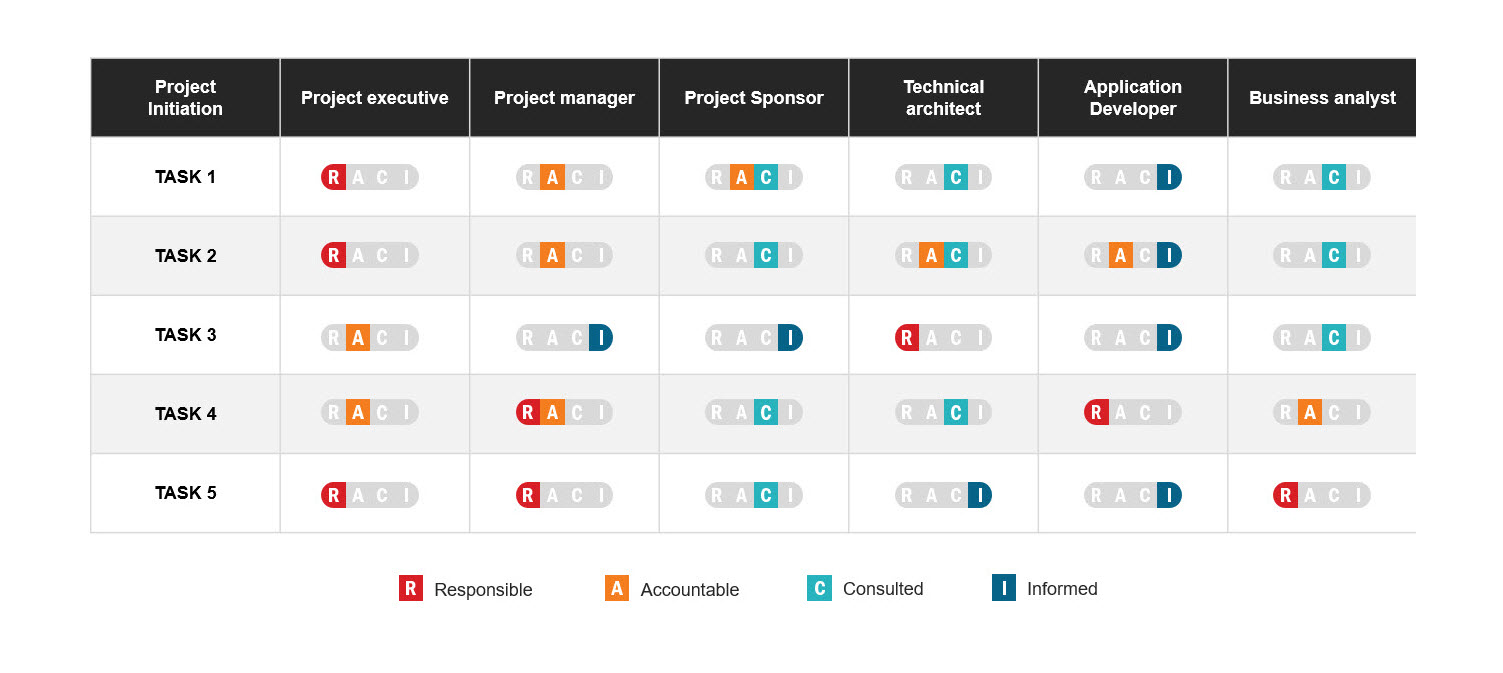Table of Contents
RACI charts are a popular tool used in project management, process improvement, and organizational change initiatives to clarify roles and responsibilities among team members. This tool helps to ensure that each team member understands what is expected of them and that the project is completed efficiently and effectively. However, despite its usefulness, many people are unfamiliar with RACI charts and may not know how to create or implement one.
In this article, I will provide a comprehensive guide to understanding and implementing RACI charts.
What Is a RACI Chart?
A RACI chart is a tool used to clarify roles and responsibilities within a team or organization. The acronym RACI stands for Responsible, Accountable, Consulted, and Informed. Each of these terms represents a different level of involvement or responsibility a team member may have in a project.
The purpose of a RACI chart is to reduce confusion, improve communication, and ensure accountability within a team. By clearly defining who is responsible, accountable, consulted, or informed for each task or activity, team members can better understand their role and how they contribute to the overall success of the project or process.
- The Responsible (R) role refers to the team member who is responsible for completing the task or activity. This person is expected to take action and ensure that the task is completed on time.
- The Accountable (A) role refers to the team member who is ultimately accountable for the success or failure of the task or activity. This person has the final say on decisions related to the task.
- The Consulted (C) role refers to the team members who are consulted for input on the task or activity. These team members are not responsible for completing the task, but their input is valuable in ensuring that the task is completed successfully.
- The Informed (I) role refers to the team members who need to be kept informed of the progress or status of the task or activity. These team members are not responsible for completing the task, but they need to be aware of its status.
Benefits of Using RACI Charts
Using a RACI chart has numerous benefits for a team or organization.
One of the main advantages is that it reduces confusion by clearly defining roles and responsibilities for each team member. This helps to avoid overlaps, duplications, or gaps in responsibilities, which can cause confusion and delay in project completion. By understanding their role and the roles of others, team members can work more efficiently toward the common goal.
Another benefit of using a RACI chart is that it improves communication within the team. When team members understand their roles and responsibilities, they can communicate more effectively with others and ensure that important information is shared with the right people. This can help to avoid misunderstandings, delays, or conflicts in the project.
In addition, using a RACI chart ensures accountability within the team. By assigning clear roles and responsibilities to each team member, it is easier to hold them accountable for their actions and outcomes. This can help to improve the quality of work, reduce errors, and increase the likelihood of project success.
Creating a RACI Chart
Step 1: Identify the tasks and activities
The first step in creating a RACI chart is to identify the tasks and activities that need to be completed. This may involve reviewing project plans, process maps, or task lists. It is important to be as specific as possible and break down larger tasks into smaller sub-tasks if necessary.
Step 2: Define the roles and responsibilities
After you have identified the tasks and activities, define the roles and responsibilities for each task. This involves assigning a RACI code to each team member involved in the task. The RACI code stands for Responsible, Accountable, Consulted, or Informed.
Step 3: Assign RACI codes to team members
Assign a RACI code to each team member for each task or activity. For example, the project manager may be accountable for the overall success of the project (A), while a team member may be responsible for completing a specific task (R), and another team member may be consulted for their expertise (C).
Step 4: Fill out the RACI chart
Fill out the RACI chart with the tasks on the left-hand side and the team members on the top row. Use the RACI codes to assign roles and responsibilities for each task or activity.
Step 5: Interpret the RACI chart
Once the RACI chart is complete, it can be used to communicate roles and responsibilities to the team members. It can also be used to identify issues, such as gaps or overlaps in responsibilities, and make adjustments as necessary.
Implementing a RACI Chart
Implementing a RACI chart involves effectively communicating it to the team and incorporating it into your project management processes.
Here are some tips for implementing a RACI chart:
- Communicate the RACI chart to the team. Share the RACI chart with all team members involved in the project and explain how it works. Make sure everyone understands their roles and responsibilities, and encourage team members to ask questions if they are unsure.
- Use the RACI chart during meetings. Refer to the RACI chart during meetings to ensure that everyone is on the same page and to avoid confusion. Use it as a tool to track progress and ensure that tasks are completed according to the defined roles and responsibilities.
- Update the RACI chart as needed. The RACI chart should be a living document that is updated as tasks and responsibilities change. Make sure to update it regularly and communicate any changes to the team.
- Integrate the RACI chart into your project management processes. Incorporate the RACI chart into your project management processes, such as task assignments, status updates, and performance evaluations. This will help to ensure that everyone is aligned and working towards the same goals.
- Train new team members on the RACI chart. When new team members join the project, make sure to train them on the RACI chart and how it works. This will help them to quickly understand their roles and responsibilities and integrate into the project team.
Best Practices For Using RACI Charts
Using a RACI chart effectively requires some best practices to be followed.
Here are some best practices for using a RACI chart:
- Keep it simple: A RACI chart should be easy to understand and use. Keep it simple by using clear language and avoiding overly complex descriptions.
- Involve all stakeholders: Involve all stakeholders in the creation and use of the RACI chart. This includes team members, project managers, and other key stakeholders who may be affected by the project.
- Define clear roles and responsibilities: Clearly define the roles and responsibilities of each team member. This will help to avoid confusion and ensure that everyone is working towards the same goals.
- Review it regularly: Regularly review the RACI chart to ensure that it remains up-to-date and relevant. This will help to ensure that everyone is aware of their roles and responsibilities and that the project is progressing.
- Ensure accountability: Use the RACI chart to ensure accountability by regularly checking that tasks are being completed by the assigned team members. This will help to ensure that everyone is contributing to the project and that it is completed on time and within budget.
- Be flexible: The RACI chart should be flexible enough to accommodate changes in the project scope or team composition. Make sure that it can be easily updated to reflect these changes.
RACI Chart Examples
Here are some examples of how a RACI chart can be used:
- Project management: A RACI chart can be used to assign roles and responsibilities to team members for each task in a project plan. This helps to ensure that everyone knows what is expected of them and that tasks are completed on time and within budget. For example, in a software development project, the RACI chart can be used to assign roles such as developer, tester, project manager, and quality assurance specialist.
- Process improvement: A RACI chart can be used to analyze and improve a process by identifying roles and responsibilities for each step. This helps to ensure that everyone understands their role in the process and that each step is completed efficiently and effectively. For example, in a manufacturing process, the RACI chart can be used to assign roles such as operator, supervisor, quality inspector, and maintenance technician.
- Organizational change: A RACI chart can be used to implement changes in an organization by identifying roles and responsibilities for each stakeholder. This helps to ensure that everyone understands their role in the change and that the change is implemented smoothly. For example, in a change management project, the RACI chart can be used to assign roles such as project sponsor, project manager, communication specialist, and training coordinator.
- Decision-making: A RACI chart can be used to facilitate decision-making by identifying who needs to be consulted and who has the authority to make decisions. This helps to ensure that decisions are made quickly and effectively. For example, in a hiring process, the RACI chart can be used to assign roles such as recruiter, hiring manager, and human resources specialist.
Conclusion
RACI charts are a powerful tool that can help teams and organizations achieve their goals more efficiently and effectively. By providing clarity around roles and responsibilities, RACI charts can reduce confusion, improve communication, and ensure accountability. Creating and implementing a RACI chart may seem daunting at first, but by following the steps outlined in this article and incorporating best practices, teams, and organizations can successfully use this tool to their advantage.
When creating a RACI chart, make sure to involve all stakeholders and keep the chart simple and easy to understand. It should also be reviewed regularly and updated as needed to reflect changes in the project or organization. By doing so, teams can ensure that everyone is on the same page and that tasks are completed on time.
Understanding and implementing RACI charts is a valuable skill for anyone involved in project management, process improvement, or organizational change. Now you can confidently create and implement a RACI chart and leverage its benefits to achieve success in your projects.
Are you using RACI Chart? Let me know your experience with it in the comments.


